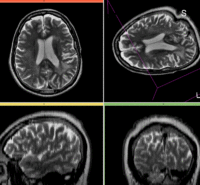Difference between revisions of "Projects:RegistrationLibrary:RegLib C09"
| Line 44: | Line 44: | ||
*Tutorial only | *Tutorial only | ||
*Image Data only | *Image Data only | ||
| − | |||
| − | |||
| − | |||
| − | |||
| − | |||
| − | |||
| − | |||
| − | |||
| − | |||
| − | |||
| − | |||
| − | |||
| − | + | ||
| − | + | [[Projects:RegistrationDocumentation:ParameterPresetsTutorial|Link to User Guide: How to Load/Save Registration Parameter Presets]] | |
=== Discussion: Registration Challenges === | === Discussion: Registration Challenges === | ||
Revision as of 17:44, 18 February 2010
Home < Projects:RegistrationLibrary:RegLib C09Back to ARRA main page
Back to Registration main page
Back to Registration Use-case Inventory
Contents
Slicer Registration Library Exampe #9: Functional MRI aligned with structural reference MRI
| this is the fixed reference image. All images are aligned into this space | this is the moving image. The transform is calculated by matching this to the reference image | LEGEND
| |
| 0.5 x 0.5 x 1.0 mm axial 512 x 512 x 176 RAS |
1.8 x 1.8 x 4 mm axial oblique 128 x 128 x 19 x 125 timepoints RAS |
Objective / Background
This is a typical example of fMRI pre-processing. Goal is to align the fMRI image with a structural scan that provides accuracte anatomical reference. The fMRI contains acquisition-related distortion and low contrast to discern much anatomical detail. We also have pathology (stroke) with variable contrast across different MRI protocols.
Keywords
MRI, brain, head, intra-subject, fMRI
Input Data
Registration Results
Download
- download entire package (Data,Presets,Tutorial, Solution, zip file 33.7 MB)
- Presets
- Tutorial only
- Image Data only
Link to User Guide: How to Load/Save Registration Parameter Presets
Discussion: Registration Challenges
- the fMRI contains acquisition-related distortions that can make automated registration difficult.
- the fMRI contains low tissue contrast, making automated intensity-based registration difficult.
- the two images often have strong differences in voxel sizes and voxel anisotropy. If the orientation of the highest resolution is not the same in both images, finding a good match can be difficult.
- there may be widespread and extensive pathology (e.g stroke, tumor) that might affect the registration if its contrast is different in the baseline and structural reference scan
Discussion: Key Strategies
- masking is likely necessary to obtain good results.
- in this example the initial alignment of the two scans is not excessive.
- because speed is not that critical, we increase the sampling rate from the default 2% to 15%.
- we also expect larger differences in scale & distortion than with regular structural scane: so we significantly (2x-3x) increase the expected values for scale and skew from the defaults.
- a good affine alignment is important before proceeding to non-rigid alignment to further correct for distortions.
